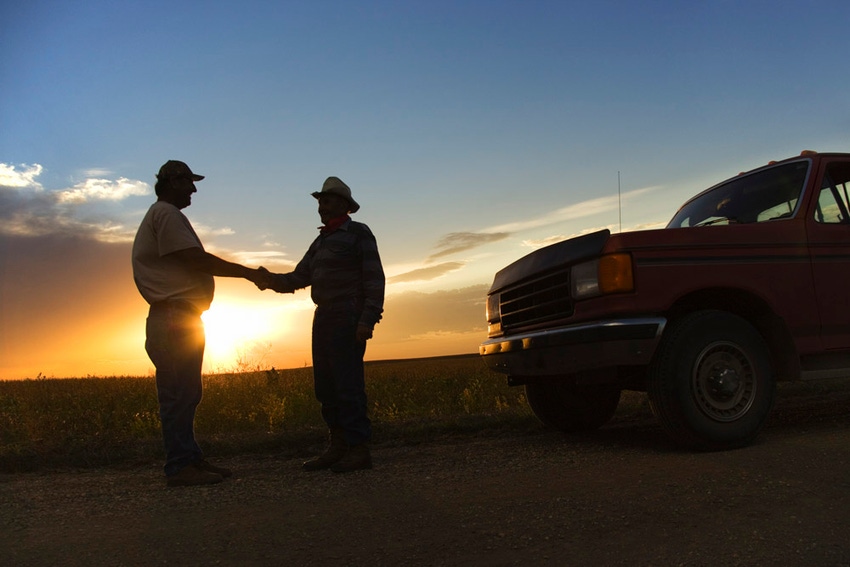9 things to include in your ag lease (that you better have in writing)
It’s really this simple: a handshake won’t fare well in court. Get it in writing.

It’s a time-honored tradition in the cattle business that a man is as good as his word and a handshake seals the deal. And in some instances, that’s still a common practice from cattle deals to grazing and hunting leases.
But the world and the cattle business is changing and the person you may think you know very well may not be the person you meet when the chips and dollars are down and the financial pain is off the charts.
That’s why you need to get it in writing, says Tiffany Dowell Lashmet, Texas AgriLife Extension agricultural law specialist in Amarillo. Regardless if you have known the person all your life or are just meeting them, a written lease clarifies things, she says.
“You never know what might happen between two folks with an oral lease, even if they are family or the best of friends,” she says. “Lease agreements certainly do not have to be lengthy and complex, but there are some terms you need to include to protect both sides.”
Dowell Lashmet says writing things down can also remind both parties of issues or situations they need to agree on before they shake on the deal. Some she pointed out include:
1. Forum clause: “If you have a tenant who doesn’t live in your area, you are identifying where you want any legal forum to be if there becomes an issue that requires court action.”
2. Dispute resolution clause: “Suing people is expensive; consider a method of avoiding court and settling the case beforehand through mediation or arbitration. These are two very different things; mediation has a third party involved and if both parties agree to settle, it’s written up and everyone goes home, or if they don’t, they go to court. But in arbitration, the arbitrator hears both sides of the case and then the arbitrator picks a winner and you are done. Generally you can’t go to court after that. Make sure you know what you are agreeing to.”
3. fee provision: “If you clarify that in a court situation, the prevailing party can recover attorney fees, you can pursue that, otherwise each are on their own.”
4. Setting a stocking rate: “If you lease me 300 acres and don’t tell me how many cattle I can put on it, I will likely put everything I own on that land. The landowner wants this term, the tenant probably does not. Also be very clear on size, weight or animal units allowed. Be aware that this number may need to change based on drought or wildfire.”
5. Term of lease and cancellation: “There are two typical lease types when dealing with grazing leases – tenancy for term or periodic tenancy. Term has a start and end date, that’s it. Periodic has a start and end date that renews itself unless one party gives written notice. Make notice of cancellation be in writing. Set a time when the notice is due.”
6. What may be done on the property?: “If limitations are not included on the lease, they don’t exist. Put it in the lease if you want it clarified. Can kids ride four-wheelers? Can anyone hunt or is it for grazing purposes only? Do they have access to corrals or just pasture? Spell out who has hunting rights or you will have a tense situation when deer season opens.”
7. Maintenance of fixed assets: “Who has to maintain things? Who has to pay for it? You can do whatever you want, but spell it out in the lease. Fences are a big deal. Who is required to maintain those fences and make sure periodic inspections are done?”
8. Hunting leases: In the area of hunting lease pointers, she said to require everyone to sign a lease and waiver.
“You want them bound by the terms of the lease, so if they breach one of those terms, you can sue for breach of contract,” Dowell Lashmet says. “But if they didn’t sign a lease, no contract exists for a claim to be based upon. A landowner might consider requiring that no parties beyond the lease may be brought onto the land without written permission from the landowner.
“Consider whether you will allow hunters to bring and utilize tree stands and deer blinds,” she said. “From a liability standpoint, landowners may want to consider not providing these, due to the number of injuries occurring each year related to tree stands and deer blinds.
“You might also want to clarify what weapons and vehicles can be used on the property. Make sure you read your insurance policy and make sure it provides coverage for injuries to people who are paying money for hunting.”
She said it also doesn’t hurt to include a statement in the lease that lessee is required to follow all state and federal laws or the lease will terminate.
9. Describe leased property and limitations: Consider including a map clearly showing leased land and any important areas. Delineate where they should enter the property and whether anybody else is going to have rights. Consider requiring a security deposit in case there is damage.
“Leasing land can be beneficial for both landowner and tenants alike,” she says. “Both parties can benefit from developing written lease agreements to protect their rights in this scenario.”
Enjoy a few laughs with Rubes cartoons
5 tips for preventing, diagnosing & treating foot rot
Seven keys to ranch profitability
8 apps for ranchers recommended by ranchers
9 new pickups for the ranch in 2016
Do your cattle fit your country? Here's how to tell
About the Author(s)
You May Also Like


.png?width=300&auto=webp&quality=80&disable=upscale)
